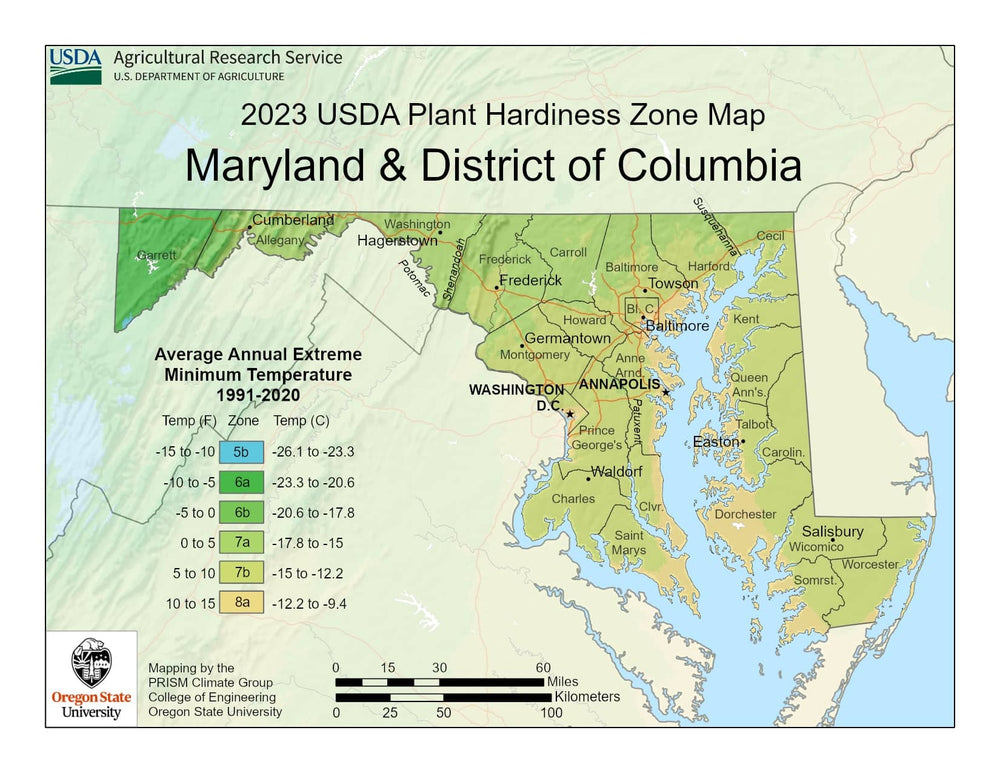Image from USDA
Characteristics of Maryland’s Planting Region
Maryland features a humid subtropical climate in the east and a humid continental climate in the west, which leads to a wide range of weather patterns throughout the year.
As a Maryland gardener, here’s what to expect:
-
Hot, humid summers, especially in central and eastern parts of the state, with average July temperatures ranging from 85°F to 88°F (29°C to 31°C)
- Cold winters in the west, with January temperatures often dropping to 20°F (-6°C) or lower
- Milder winters near the Chesapeake Bay, with minimum temperatures around 30°F (-1°C)
- Annual precipitation of 40 to 45 inches (102–114 cm), fairly evenly distributed through the year
- A growing season that ranges from 140 days in the mountains to 200+ days near the coast
Maryland’s planting calendar is longer than many northern states, giving you two distinct planting windows—spring and fall—for cool-season crops, and a long summer for everything else.

Challenges of Growing in Maryland
Variable Weather
Maryland is known for its unpredictable spring weather—late frosts, sudden heatwaves, and even spring snow in the mountains can wreak havoc on early plantings. Fall frosts can also arrive quickly in the western regions.
Humidity & Fungal Disease
Maryland’s warm, humid summers create the perfect environment for fungal diseases to thrive. Common issues include powdery mildew, downy mildew, tomato blight, and various forms of leaf spot, all of which can severely impact plant health and yields. To mitigate these problems, gardeners should prioritize proper plant spacing for airflow, use disease-resistant varieties when possible, and avoid overhead watering to keep foliage dry.
Diverse Soils
Soil types in Maryland vary significantly by region, which can affect how and what you grow. Western Maryland is known for its rocky, well-drained soils, which are ideal for root vegetables but may require the addition of organic matter to improve fertility. Central Maryland features loamy, nutrient-rich soils with excellent water retention, making it one of the best areas for general gardening.

The Benefits of Using a Greenhouse in Maryland
Adding a greenhouse to your Maryland garden opens up a world of growing potential. Here's how a sheltered growing space can transform your garden:
1. Extend Your Growing Season
- Without a Greenhouse: Outdoor planting is risky before mid-April and often ends by late October, especially in the mountains.
- With a Greenhouse: Start seeds in early March and keep harvesting through early December—or even year-round with a little heat and insulation.
Learn more about your area's specific growing dates and the best vegetables to plant in each part of Maryland.

Customer images of their Greenhouse setup in Maryland
2. Grow a Wider Variety of Vegetables Without a Greenhouse:
- Without a Greenhouse:
Maryland supports outdoor crops such as:
|
Sweet corn Peppers Corn Potatoes |
Squash Melons Okra Apples |
- With a Greenhouse:
A controlled environment enables growing a lot more:
|
Cilantro Spinach Kale Arugula Swiss chard Broccoli Limes Peas |
Brussels sprouts Cabbage Carrots Radishes Beets Turnips Celery Cucumber |
Bell peppers Eggplant Figs Green beans Asparagus Artichokes Kohlrabi Melons |

